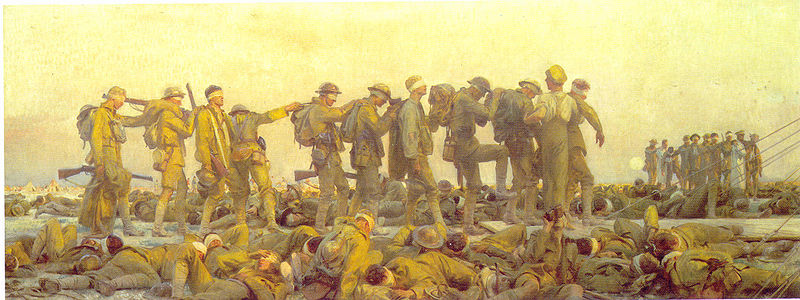Morbid Monday: Gassed

In July 1918, the then 62 year old master portrait artist John Singer Sargent went to France to visit the battlefields. He had been commissioned to create a large painting celebrating the cooperation between British and the new-to-the-conflict American troops for a Hall of Remembrance in Britain. He spent time on the Western front at Arras and later at Ypres, the center of which had been all but wiped off the map in 1915.
While there, Sargent was moved by the sight of soldiers, rendered blind and burned by use of airborne chemicals, being led by orderlies to medical care. Chemical warfare was illegal then, by the terms of the Hague Treaty signed in 1899, but that did not stop both sides from eventually using a variety of horrifying chemical agents during the war, starting with the German attack on Ypres and elsewhere in 1914. The troops on the ground were caught unprepared, with nothing to protect them from the debilitating effects of the gasses, and they suffered horrible burns, were blinded, and many died in agony.
The first basic gas masks had been developed decades earlier for use in mine shafts which could become filled with dangerous natural gasses. Quickly, new designs were added and brought to the battlefield. Images of soldiers with their faces obscured by the masks became the iconic image of the war.
Sargent captured two groups of injured men in his painting, led by orderlies. In the background, healthy men play football while more injured and dying men line the road in the foreground. The war was over just a few months after he sketched these images. The painting itself, titled “Gassed” is massive: 20’ x 7 1/2’, and now hangs at the Imperial War Museum London, kept company by its incredible WWI collection.
Details and sketches from Sargent’s painting “Gassed”
More Links from the day’s Twitterings
In WWI an estimated 100,000 men were killed through the use of poisoned gas on the battlefield
Mickey Mouse gas masks for children from WWII- Meant to look like a fun toy
History of gas masks on Wikipedia
Join us each Monday on Twitter and follow our #morbidmonday hashtag, for new odd and macabre themes each week: Atlas Obscura on Twitter
Previously:
Morbid Monday: Chung Ling Soo & the Bullet Trick That Went Horribly Wrong



Follow us on Twitter to get the latest on the world's hidden wonders.
Like us on Facebook to get the latest on the world's hidden wonders.
Follow us on Twitter Like us on Facebook